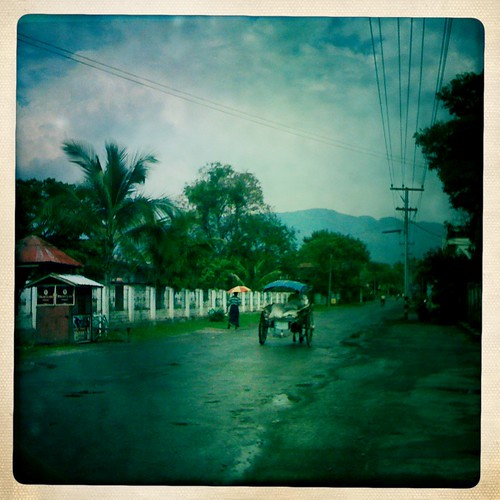
|
|
Main Street, Burma, originally uploaded by Mister Wind-Up Bird. |
“I do not like H-A. Very sorry, do you have anothers?” We were in the tiny office of a Yangon black market money changer. Two paperback-sized stacks of thousand kyat notes lay on the table in front of us. We had agreed on a rate, walked in 40-degree heat to our hotel to fetch two mint-condition $100 US bills we had brought from Thailand, and delivered them to the money changer. Now he was refusing to accept them because he didn’t like the serial numbers.
“No, we do not,” I said, with more than a trace of exasperation. Janelle made a sputtering sound.
The black marketeer was polite, but firm. “Very sorry, maybe you can change in Bagan.”
US dollars are widely used in SE Asia alongside the local currency. In Cambodia, they are even dispensed by the ATMs. But Burma is different. Burma has no ATMs, no credit card readers, no international banks, and the official exchange rate is a fraction of the black market. You have to bring in all the US dollars you will need as cash, plus extra for emergencies, and exchange at whatever rate you can negotiate. To make it even more frustrating, the tiniest rip, dye mark, stamp, or even crease and the bill will be politely but firmly refused.
As, apparently, will bad serial numbers. We had heard that CB- prefixed bills had been counterfeited by North Korea, but HA? More counterfeiting? A ploy to distract us? Indo-Burmese superstition? Who knows?
Not letting things like this get overshadow the positives is important. The Republic of the Union of Myanmar is poor, isolated and supremely fucked up, but also stunningly beautiful and incredibly charming. Taxi drivers wear traditional longyi and take their hands off the wheel to give a wai gesture toward temples as they zip by in rattling 30-year-old Toyotas. Westerners are stared at in the street, but smile and wave and you usually get a wide grin back. Astrological omens dictate the government spends hundreds of millions to move the capital to the middle of nowhere, and the devout have covered religious monuments in billions of dollars of gold, but the country’s largest city goes without street lights. Meanwhile, the countryside continues as it did decades, if not centuries ago, with rice planted by hand, fields plowed by ox, and horsecarts taking tribal people to market. It’s all seriously National Geographic.
We’re back in Bangkok, a 90-minute flight from Yangon that propels you 40 years ahead. I have tons to say about Myanmar/Burma, though the next couple of days are going to involve running errands and traveling, so it may take a while to get it out of my notebook and onto the haiku factory. But sit tight and you can hear how we got to be treated like rock stars in Yangon, saw the thousands of stupas of Bagan by horsecart and cruised through the stilt villages and floating gardens of Inle Lake, easily one of the most incredible places we’ve ever been.
One Comment